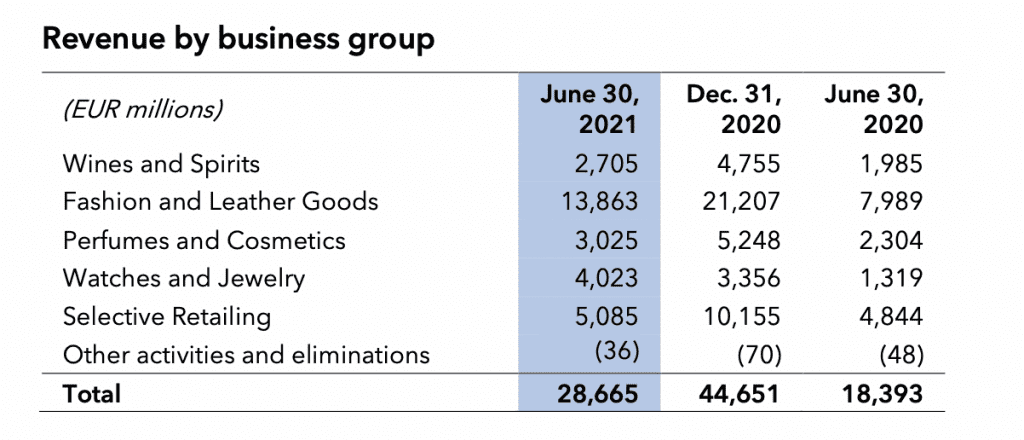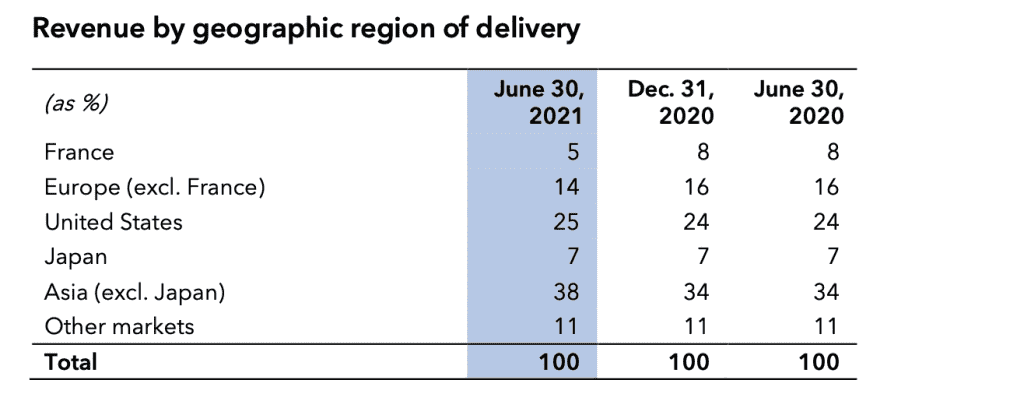Sales at LVMH Moët Hennessy Louis Vuitton were up for the first half of the year, signaling a turnaround in the luxury goods segment following “severely disrupted” revenues as a result of the COVID-19 pandemic. On Monday, the Paris-based luxury goods titan reported revenues of 28.7 billion euros ($33.9 billion) for the first half of 2021, which ended on June 30, up 56 percent compared to the same period in 2020, with such gains driven particularly by “accelerated growth” in the second quarter of 2021. LVMH revealed that the Fashion & Leather Goods division, which is its largest business group, achieved record levels of revenue with organic growth of 81 percent compared to 2020, and 38 percent compared to 2019, with sales in the U.S. and Asia “up sharply since the start of the year.”
Specifically addressing its Fashion & Leather Goods division, which generated 13.86 billion euros ($16.37 billion) in revenue for the half of the year, and 7.13 billion euros ($8.42 billion) during Q2, LVMH stated that its “largest brands” fared especially well. For instance, its marquee label Louis Vuitton “delivered a remarkable performance and maintained its profitability at an exceptional level,” noting that “due to the desirability of its iconic designs, purchases of many are subject to a waiting list.” The group says that it plans to “maintain strong creative momentum at Louis Vuitton, further extend product offer in all categories, [and] continue to deliver unique experiences across store network and digital universe.”
At the same time, the group stated that Christian Dior, another big player on its roster, had “an excellent first half with strong growth among local customers across all its product categories.” For the rest of the year, LVMH os looking to “pursue strong growth in all markets” for Dior. Elsewhere in the division, Hedi Slimane’s ready-to-wear and leather goods collections for Celine “were hugely successful,” while Fendi and Loewe joined the aforementioned brands in terms of performing well. Not listed among the names that LVMH said were doing particularly well in terms of “gaining market share across all geographies and achieving record levels of revenue and profitability”? The Matthew Williams-led Givenchy, for one, which “reached a key milestone with the arrival in stores of Williams’ first collection,” and Marc Jacobs. LVMH did, however, reveal that Jacobs “performed very well over the period.”
Finally, LVMH highlighted the “successful integration of Tiffany, which has performed extremely well since its acquisition” late last year. The New York-based brand, whose business was consolidated for the first time in the first half, “has benefited from the new team’s focus on its iconic products,” per LVMH, helping it to achieve “an excellent half-year,” driven by particularly strong momentum in Asia and the United States. “Tiffany will aim to maintain the pace of its growth in the second half of the year,” according to LVMH, drawing in particular on “an acceleration in China, and the launch of a new collection of gold jewelry, premiering in the U.S.”

Reflecting on Watches and Jewelry as a whole, LVMH stated that with the arrival of the prestigious Maison Tiffany, the division is entering “a new phase of its long-term development … as a major player in a highly promising business segment, with numerous strengths and a powerful appeal.”
In terms of revenues by business group, LVMH stated that the breakdown “changed appreciably” during the first half of the year, with “contributions of Watches and Jewelry, and Fashion and Leather Goods increasing by 7 points (entirely due to the consolidation of Tiffany) and 5 points, respectively, to 14 percent and 48 percent, while the contributions of Selective Retailing, Perfumes and Cosmetics, and Wines and Spirits decreased by 9 points, 2 points and 1 point, respectively, to 18 percent, 11 percent, and 9 percent.”
As for revenue by region, “the U.S. and Asia delivered an excellent performance” for the first half of the year, as brick-and-mortar stores have reopened en mass and vaccination campaigns have reached a significant amounts of the population. The Asia region excluding Japan accounted for 38 percent of revenue for the first half of the year, followed by the U.S., which represented 25 percent of the group’s revenues. LVMH CFO Jean Jacques Guiony stated in a corresponding conference call on Monday that demand in China, in particular, shows no sign of slowing across any of its divisions, as the Chinese market remains on track to become the biggest luxury market by 2025. Meanwhile, Europe and Japan “recorded more limited growth.”

Reflecting on the first half of the year and looking ahead, LVMH chairman and CEO Bernard Arnault stated that the conglomerate “has enjoyed an excellent half-year and is reaping the benefits of having continued to innovate and invest in its businesses throughout the pandemic despite being in the midst of a global crisis. The creativity, the high-quality and enduring nature of our products and the sense of responsibility that drives us, have been critical in enabling us to successfully withstand the effects of the pandemic.”
Finally, on the topic of future mergers and acquisitions, a particularly relevant one in light of the larger trend of consolidations in the upper echelon of the industry, in a call with analysts on Monday, Guiony stated that the group does not have anything big in the works right now. “We have to absorb Tiffany,” he said. “So, there is no large acquisition on the table.” It appears that LVMH is focusing for the time being on smaller-scale investments and acquisitions, such as the newly-announced minority stake that it is taking in former Celine creative director Phoebe Philo’s soon-to-launch eponymous label, and its headline-making 60 percent stake in Off-White, which was announced last week.













